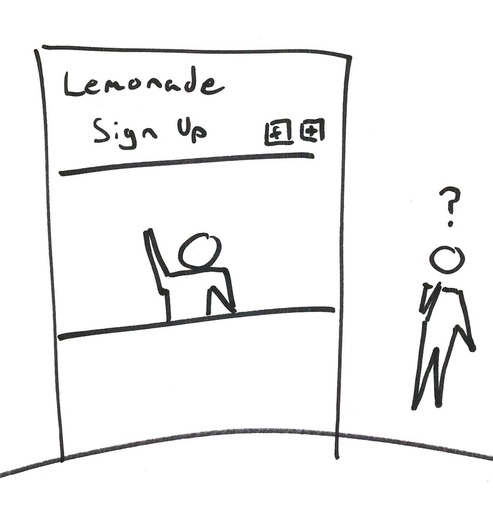Acquiring clients at a breakeven or a slight loss and then making substantial profits on back-end7/6/2013
Acquiring clients at a breakeven or a slight loss and making substantial profits on back-end repurchasing is one of the most overlooked and underutilized methods of client growth and generation available to you. But it can’t work for you until you first recognize a very important fact. If your business or practice is one that has a high probability of clients coming back, again and again, to repurchase from you the same or different products or services, you owe it to that business or practice to do everything within your power to get clients into the buying stream as quickly and easily as you possibly can.
Many companies increase their clients and profits merely by shifting their focus from trying to make a huge profit on the acquisition of a new client to making their real profit on all the repeat purchases that result from those new clients. Knowing how much a client will spend with you over a period of years tells you how much you can spend on the process of acquiring a client. The most profitable thing you’ll ever do for your business or career is to understand and ethically exploit the marginal net worth of a client. What is the current lifetime value of one of your clients? It’s the total profit of an average client over the lifetime of his or her patronage—including all residual sales—less all advertising, marketing, and incremental product or service-fulfillment expenses. If you haven’t calculated your clients’ marginal net worth yet, here’s how to do it: 1. Compute your average sale and your profit per sale. 2. Compute how much additional profit a client is worth to you by determining how many times he or she comes back. 3. Compute precisely what a client costs by dividing the marketing budget by the number of clients it produces. 4. Compute the cost of a prospect the same way. 5. Compute how many sales you get for so many prospects (the percentage of prospects who become clients). 6. Compute the marginal net worth of a client by subtracting the cost to produce (or convert) the client from the profit you expect to earn from the client over the lifetime of his or her patronage. Once you’ve calculated the lifetime value of a client, you have many ways to accomplish your break-even objective. Remember, the goal isn’t just to cut the price of the first purchase. The goal is to make that first purchase so much more appealing that people find it harder to say no than yes . . . please! While reducing the price of your product or service is the most common and obvious way to get the first sale, there are other powerful ways to obtain first-time buyers. For example, you can calculate your allowable marketing or selling cost, which is how much money you’re willing to either spend or forgo receiving (by reducing the selling price), in order to make that very first purchase more appealing to a prospective client. Let’s say your product or service sells for $200 and your cost is $100. Also assume your average client repurchases several times a year for several years and you will realize a good long-term profit. Obviously you can reduce your price by $100 on the first sale to reach a break-even point and gain a new client. But you could put that $100 to a number of other uses. You could keep the price at $200 and use the $100 as “spiff” or extra selling incentives to your salespeople. Giving salespeople greater financial incentive to bring in new, first-time clients can produce tremendous results in the right situation. You could also use that same $100 to buy more of your product or service. So you still charge the full $200, but you give prospects twice the quantity on the first purchase. Or you could take the $100 and use it to buy other complementary products or services (at wholesale) to package and add to your product or service without raising the $200 price—so the value of your offer becomes far greater and thus more attractive. Or you could use that $100 to invest in advertising, sales letters, additional salespeople, free seminars, or any other marketing and selling programs. Or you could rent promotional space in someone’s store or trade-show booth and pay them the $100 for every new client you gain through their facility. The only limitation you have on how to use your allowable marketing or selling cost to help you strategically break even on the initial sale is that it must be ethical and legal. And after testing it out it must be economically viable in the long term. Getting Everything You Can Out of All You've Got: 21 Ways You Can Out-Think, Out-Perform, and Out-Earn the Competition by Jay Abraham Creativity is by its nature an act of boldness and rebellion. You are not accepting the status quo or conventional wisdom. You are playing with the very rules you have learned, experimenting and testing the boundaries. The world is dying for bolder ideas, for people who are not afraid to speculate and investigate. Creeping conservatism will narrow your searches, tether you to comfortable ideas, and create a downward spiral—as the creative spark leaves you, you will find yourself clutching even more forcefully to dead ideas, past successes, and the need to maintain your status. Make creativity rather than comfort your goal and you will ensure far more success for the future.
Mastery by Robert Greene A producer is someone who creates value and shares knowledge with others. In the process, a producer helps improve lives and earns continuous active and passive income.
Step one is committing to becoming a producer. To attract customers, and partner with affiliates who’ll help promote your products, follow these principles:
Higher prices lead to greater affiliate participation. Whether your product costs $10 or $10,000, it’ll require roughly the same amount of effort for an affiliate to promote it. As a result, most affiliates will choose to invest their time into selling high-priced products that provide substantial returns. Printed books and ebooks, while often providing wonderful content, are ill suited for commission-driven relationships as are most other products that sell for under $500. Today’s successful partnerships involve the promotion of products priced between $500 and $4,995. Products above and below these price points continue to be sold, but they represent the two ends of the bell curve. Successful Internet marketers offer products at the center of the curve—and right now that sweet spot is roughly $2,500. Higher commissions mean happy affiliates. Selling a highpriced product isn’t the whole story. You must also be generous on commissions paid. Today, 40%-50% commission rates are commonplace, as is the payment of an additional 10% for second-tier affiliates. Second-tier affiliates, also known as brokers, help recruit affiliates for a product launch. When a product is sold, a second-tier affiliate typically receives 10% of the purchase price. Naturally, this cuts into your net profits. However, industry leaders understand that 40%-50% is a price worth paying for instant massive exposure, immediate income, and adding thousands of hopefully satisfied customers to their sales funnel. Continuity programs create long-term relationships. While instant cash is always nice, long-term passive income is even better. Whether they consist of bi-weekly one-on-one coaching, monthly product shipments, quarterly VIP programs, or annual membership dues, continuity programs provide ongoing benefits for both you and your affiliates. Developing products from scratch is hard. But even more difficult is creating products that fulfill audience needs, provide immense value, are of superior quality, and convert prospects to paying customers. Success requires satisfying all four criteria. Today, he who has the list controls the game. Internet Prophets: The World's Leading Experts Reveal How to Profit Online by Steve Olsher Why you need early adopters and why you only need the most basic product to start a business5/8/2013
We had a working engine of growth. The gross numbers were small because we were selling the product to visionary early customers called early adopters. Before new products can be sold successfully to the mass market, they have to be sold to early adopters. These people are a special breed of customer. They accept—in fact prefer—an 80 percent solution; you don’t need a perfect solution to capture their interest.
Early adopters use their imagination to fill in what a product is missing. They prefer that state of affairs, because what they care about above all is being the first to use or adopt a new product or technology. In consumer products, it’s often the thrill of being the first one on the block to show off a new basketball shoe, music player, or cool phone. In enterprise products, it’s often about gaining a competitive advantage by taking a risk with something new that competitors don’t have yet. Early adopters are suspicious of something that is too polished: if it’s ready for everyone to adopt, how much advantage can one get by being early? As a result, additional features or polish beyond what early adopters demand is form of wasted resources and time. This is a hard truth for many entrepreneurs to accept. After all, the vision entrepreneurs keep in their heads is of a high-quality mainstream product that will change the world, not one used by a small niche of people who are willing to give it a shot before it’s ready. That world-changing product is polished, slick, and ready for prime time. It wins awards at trade shows and, most of all, is something you can proudly show Mom and Dad. An early, buggy, incomplete product feels like an unacceptable compromise. Minimum viable products range in complexity from extremely simple smoke tests (little more than an advertisement) to actual early prototypes complete with problems and missing features. Deciding exactly how complex an MVP needs to be cannot be done formulaically. It requires judgment. The lesson of the MVP is that any additional work beyond what was required to start learning is waste, no matter how important it might have seemed at the time. The Lean Startup: How Today's Entrepreneurs Use Continuous Innovation to Create Radically Successful Businesses by Eric Ries WHY DO SOME PEOPLE GAIN LEVELS OF SUCCESS SO MUCH higher than others’?
Frequently it’s due to the fact that they have a better philosophical strategy. They approach everyone they deal with in a totally different and more effective way than anyone else does. And while their competitors are usually unable to figure out this strategy, it is one anyone in business can successfully employ by simply changing his or her focus from “me” to “you.” This is true whether you own a business of your own or work for a corporation. This simple adjustment in your focus is the key to what I believe is the most powerful business (and life) strategy you can employ. I call it the Strategy of Preeminence. Once you begin to use it you will always—not just sometimes, but always—stand out in the minds, hearts, and checkbooks of your client, your employees, your employer, or your boss as the very best there is. The preeminent choice. The Strategy of Preeminence is quite simply the ability to put your clients’ needs always ahead of your own. When you master that your success will naturally follow. It’s amazing how many people and companies will say and do whatever it takes to make a one-time sale rather than taking the time to understand the clients’ desired outcome. And then having the courage and the concern to tell that client that what they really need is much less than what they told you they wanted. You may, when you take this approach, end up with a smaller initial sale, but you will have just made a new friend, someone who will remember you the next time. And who will, no doubt, tell his friends about you and your company. Getting Everything You Can Out of All You've Got: 21 Ways You Can Out-Think, Out-Perform, and Out-Earn the Competition by Jay Abraham |
Click to set custom HTML
Categories
All
Disclosure of Material Connection:
Some of the links in the post above are “affiliate links.” This means if you click on the link and purchase the item, I will receive an affiliate commission. Regardless, I only recommend products or services I use personally and believe will add value to my readers. I am disclosing this in accordance with the Federal Trade Commission’s 16 CFR, Part 255: “Guides Concerning the Use of Endorsements and Testimonials in Advertising.” |
Photos from Wesley Oostvogels, Thomas Leuthard, swanksalot, Robert Scoble, Lord Jim, Pink Sherbet Photography, jonrawlinson, MonsterVinVin, M. Pratter, greybeard39, Stepan Mazurov, deanmeyersnet, Patrick Hoesly, Lord Jim, Dcysiv Moment, fdecomite, h.koppdelaney, Abode of Chaos, pasa47, gagilas, BAMCorp, cmjcool, Abode of Chaos, faith goble, nerdcoregirl, Adrian Fallace Design & Photography, jmussuto, Easternblot, Jeanne Menjoulet & Cie, aguscr, h.koppdelaney, Saad Faruque, ups2006, Unai_Guerra, erokism, MsSaraKelly, Jem Yoshioka, tony.cairns, david drexler, Reckless Dream Photography, Raffaele1950, kevin dooley, weegeebored, Cast a Line, Zach Dischner, Eddi van W., kmardahl, faungg's photo, Alan Light, acme, Evan Courtney, specialoperations, Mustafa Khayat, darkday., Orin Zebest, Robert S. Donovan, disparkys, kennethkonica, aubergene, Nina Matthews Photography, infomatique, Patrick Hoesly, j0sh (www.pixael.com), SmithGreg, brewbooks, tjsander, The photographer known as Obi, Simone Ramella, striatic, jmussuto, m.a.r.c., jfinnirwin, Nina J. G., pellesten, dreamsjung, misselejane, Design&Joy, eeskaatt, Bravo_Zulu_, No To the Bike Parking Tax, Kecko, quinn.anya, pedrosimoes7, tanakawho, visualpanic, Brooke Hoyer, Barnaby, Fountain_Head, tripandtravelblog, geishaboy500, gordontarpley, Rising Damp, Marc Aubin2009, belboo, torbakhopper, JarleR, aakanayev, santiago nicolau, Official U.S. Navy Imagery, chinnian, GS+, andreasivarsson, paulswansen, victoriapeckham, Thomas8047, timsamoff, ConvenienceStoreGourmet, Jrwooley6, DeeAshley, ethermoon, torbakhopper, Mark Ramsay, dustin larimer, shannonkringen, Stf.O, Todd Huffman, B Rosen, Lord Jim, Jolene4ever, Ben K Adams, Clearly Ambiguous, Daniele Zedda, Ryan Vaarsi, MsSaraKelly, icebrkr, jauhari, ajeofj3, jenny downing, Joi, GollyGforce, Andrew from Sydney, Lord Jim, 'Retard' (says University of Missouri), drukelly, Sullivan Ng, jdxyw, infomatique, AlicePopkorn, RAA408, Abode of Chaos, SaMaNTHa NiGhTsKy, as always..., D@LY3D, Angelo González, the sugary smell of springtime!, Marko Milošević, pedrosimoes7, MartialArtsNomad.com, 401(K) 2013, Sigfrid Lundberg, MoneyBlogNewz, NBphotostream, the stag and doe, Jemima G, bablu121, .reid., jared, EastsideRJ, Alex Alvisi, Marie A.-C., geishaboy500, modomatic, starsnostars., Hardleers, Sarah G..., donielle, Danny PiG, bigcityal, || UggBoy♥UggGirl || PHOTO || WORLD || TRAVEL ||, -KOOPS-, seafaringwoman, kingkongirl, Richard Masoner / Cyclelicious, Hans Gotun, gruntzooki, Duru..., Vectorportal, Peter Hellberg, Alexandre Hamada Possi, Santi Siri, Joshua Rappeneker, a little tune, Patricia Mangual, erokism, woodleywonderworks, Philippe Put, Purple Sherbet Photography, Abode of Chaos, greybeard39, swanksalot, greyloch, Omarukai, Marc_Smith, SLPTWRK, Peter Alfred Hess, illum, MarioMancuso, willc2, _titi, Lightsurgery, Rennett Stowe, feverblue, Esteman., Keith Allison, DCist, h.koppdelaney, Mike Deal aka ZoneDancer, Jos Dielis, The Wandering Angel, Nathaniel KS, MsSaraKelly, Frank Lindecke, Kara Allyson, JeremyGeorge, deoman56, gagilas, Xoan Baltar, Luke Lawreszuk, Eric-P, fdecomite, lorenkerns, masochismtango, Adrian Fallace Design & Photography, anarchosyn, -= Bruce Berrien =-, radiant guy, Free Grunge Textures - www.freestock.ca, El Bibliomata, antmoose, Pedro Belleza, Fitsum Belay/iLLIMETER, Nathan O'Nions, denise carbonell, swanksalot, ▓▒░ TORLEY ░▒▓, Marco Gomes, Justin Ornellas, jenni from the block, René Pütsch, eddieq, thombo2, Ben Mortimer Photography, :moolah, ideowl, joaquinuy, wiredforlego, Rafa G. _, derrickcollins, Fishyone1, ben pollard, Admiralspalast Berlin, Georgio, garybirnie.co.uk, fiskfisk, MoreFunkThanYou, xJason.Rogersx, kevin dooley, David Holmes2, Kris Krug, JD Hancock, Images_of_Money, andriux-uk events, Tyfferz, decafinata, jonrawlinson, isado, Lohan Gunaweera, Derek Mindler, Mike "Dakinewavamon" Kline, themostinept, kiwanja, erokism, dktrpepr, Keoni Cabral, denise carbonell, Neal., tonystl, ericmay, Ally Mauro, erokism, Georgie Pauwels, anitakhart, Ivan Zuber, r2hox, Aka Hige, badjonni, striatic, Arry_B, 401(K) 2012, pvera, Lord Jim, Dredrk aka Mr Sky, TerryJohnston, eschipul, wiredforlego, Yuliya Libkina, fabbio, Justin Ruckman, David Boyle, Matthew Oliphant, Keoni Cabral, Thaddeus Maximus, Abode of Chaos, matthias hämmerly, dospaz, LadyDragonflyCC - >;<, CassiusCassini2011, Abode of Chaos, Jorge Luis Perez, infomatique, Mark Gstohl, AliceNWondrlnd, ç嬥x, ssoosay, striatic, NASA Goddard Photo and Video, feverblue, MsSaraKelly, kohlmann.sascha, Vox Efx, country_boy_shane, paularps, Gage Skidmore, HawkinsSteven, Cam Switzer, Arenamontanus, anieto2k, Georgie Pauwels, my camera and me, Lord Jim, nolifebeforecoffee, Joris_Louwes, Kemm 2, VinothChandar, DeeAshley, brewbooks, craigemorsels, Boris Thaser, Poster Boy NYC, ssoosay, guzzphoto, sachac, chefranden, Wanja Photo, Samuel Petersson, onlyart, samsaundersleeds, Ghita Katz Olsen, mcveja, matthewwu88, Victor Bezrukov, JasonLangheine, erokism, vitroid, thethreesisters, charlywkarl, Sharon & Nikki McCutcheon, Ol.v!er [H2vPk], mikecogh, tec_estromberg, noii's, nicholaspaulsmith, Tucker Sherman, Phil Grondin, Cea., Randomthoughtstome, dcobbinau, rafeejewell, pedrosimoes7, lumaxart, marfis75, roland, RLHyde, David Boyle in DC, Sigfrid Lundberg, Thomas Geiregger, Uberto, bgottsab, Conor Lawless, phphoto2010, Steven | Alan, ckaroli, dweekly, AleBonvini, 드림포유, die.tine, MsSaraKelly, equinoxefr, Sarabbit, Abode of Chaos, Galantucci Alessandro, LadyDragonflyCC - >;< - Spring in Michigan!, Alan Gee, Johan Larsson, SoulRider.222, Robert S. Donovan, amslerPIX, cfaobam, Amy L. Riddle, Bladeflyer, Blomstrom, pumpkincat210, Lord Jim, Symic, kevin dooley, pixelthing, Nelson Minar, Fraser Mummery, The Booklight, edenpictures, everyone's idle, betsyweber, h.koppdelaney, ark, Ben Fredericson (xjrlokix), dphiffer, Jeff Kubina, istolethetv, dullhunk, Tambako the Jaguar, fdecomite, The Daily Ornellas, Badruddeen, kevindooley, mnem, Reyes, sadaton, Mary..K, akunamatata, Dennis Vu Photography for Unleashed Media, mitch98000, ganesha.isis, maria j. luque, doneastwest, w00tdew00t, kevindooley, NightFall404, Infrogmation, nandadevieast, darkpatator, Christos Tsoumplekas, sicamp, Hello Turkey Toe, cliff1066™, James Jordan, gailf548, andrew_byrne, infomatique, graphia, -= Bruce Berrien =-, aphrodite-in-nyc, jmussuto, eiko_eiko, Emily Jane Morgan, _Imaji_, kait jarbeau is in love with you, Leeks, h.koppdelaney, paul-simpson.org, Pinti 1, Namlhots, -KOOPS-






 RSS Feed
RSS Feed

